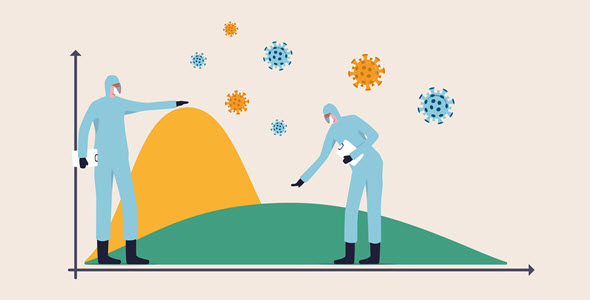By the bioMérieux Connection Editors
A novel disease such as COVID-19 presents uncertain and often frightening situations around the world, but with the help of epidemiologists, public health authorities can use existing and developing data to help them make decisions to protect public health.
Epidemiology is the study of the distribution and determinants of health-related states (such as diseases) and events (e.g., natural disasters, terrorism) in specified populations. As the SARS-CoV-2 virus originated and took hold in Wuhan, China, and especially as it started to travel around the globe, epidemiologists collected data in real time. These types of studies are extremely important because they can aid in the analysis and tracking of the outbreak, leading to robust evidence to help support and inform public health decision making. For example, comparing data from other cities and countries could help authorities draw conclusions about how best to respond when cases start appearing in their own region.
The problem with real-time epidemiological studies, especially amidst a global pandemic, is that data is constantly in flux. COVID-19 is a rapidly evolving situation, with new cases appearing every hour. Epidemics and pandemics are generally characterized by numbers—global cases, transmission rate, how many days one can shed the virus, mortality rate, and other statistics. In the case of COVID-19, pinning down a mortality rate has been especially difficult.
Dr. Christine Kreuder Johnson, a UC Davis professor of epidemiology and ecosystem health, stated in a recent Healthline article, “The death rate really is something we just have to take with a grain of salt until we have enough information.” This observation applies in other ways as well—until scientists understand the true extent of the outbreak and retrospective analyses take place, we won’t have definitive numbers at our disposal. However, while our current situation may be rapidly evolving, real-time data is still extremely important to support decision-making, especially when we combine it with our knowledge of infection prevention and epidemiological data from past outbreaks.
How Can Epidemiological Data from Past Outbreaks Help Us Now?
COVID-19 is the first pandemic since the 2009 H1N1 swine flu, officially receiving this designation from the World Health Organization (WHO) on March 11. Studying past outbreaks such as H1N1 can help scientists better estimate the outcomes of COVID-19 and identify and recommend the best measures to slow its spread.
Although COVID-19 is caused by a coronavirus and not an influenza virus, Marc Lipstich, a professor of epidemiology and director of the Center for Communicable Disease Dynamics at Harvard University, said in a recent Scientific American article, “Past influenza pandemics give some sense of what the overall [trajectory] of a virus like this would be because the reproductive number of this virus is pretty similar to that of a pandemic flu.”
In addition to the H1N1 pandemic, which killed more than half a million people, comparisons have also been drawn between the 1918 influenza pandemic and COVID-19, to better support social distancing and shelter-at-home policies. Specifically, epidemiological studies comparing the response to the 1918 influenza pandemic in St. Louis and Philadelphia are often referenced. The public health response differed dramatically between the two cities, with St. Louis authorities quickly introducing social distancing measures after the first cases were reported in their city, and Philadelphia continuing to operate as usual, even throwing a parade in which 200,000 people attended.
As a result, St. Louis experienced one of the lowest excess death rates in the nation, while in Philadelphia, cases surged, panic gripped the city, and 1,700 deaths were reported in a single day at the peak of the pandemic. While these real-life lessons were learned the hard way in 1918, they can provide today’s public health officials with guidance on how to manage the current pandemic.
Using COVID-19 Epidemiological Data in The Future
Studies like the St. Louis/Philadelphia study already exist for COVID-19. Lipstich and his colleagues analyzed the timing of control measures and community spread of COVID-19 in Wuhan and Guangzhou, China and found that early intervention, relative to the course of the disease in the population, resulted in Guangzhou having lower epidemic sizes and peaks than Wuhan in the first wave of the outbreak.
However, fears of possible resurgence in areas of China remain on the horizon. “It’s time to relax the lockdown, but we need to be alert for a potential second wave of infections,” said Ben Cowling, an epidemiologist at the University of Hong Kong, in a recent Nature article. Some regions in China have seen an uptick of new infections, a sign that the situation will need to be monitored closely in other parts of the world as well, even after the infections peak.
Dealing with a resurgence of infections would be a difficult task, but the data epidemiologists are gathering now would help inform the public health response. And, in the same way that past pandemics have helped inform the response to the current pandemic, data that scientists gather now will help future generations.
In addition to statistics such as reproductive rate and mortality rate, scientists are also gathering data about the virus itself. Understanding the genetics of SARS-CoV-2 contributes to our understanding of how it spreads and how to fight it. Each piece of data contributes to a larger epidemiological picture that will not only help us fight new coronaviruses that emerge in the future, but other infectious diseases as well.
Opinions expressed in this article are not necessarily those of bioMérieux, Inc.



